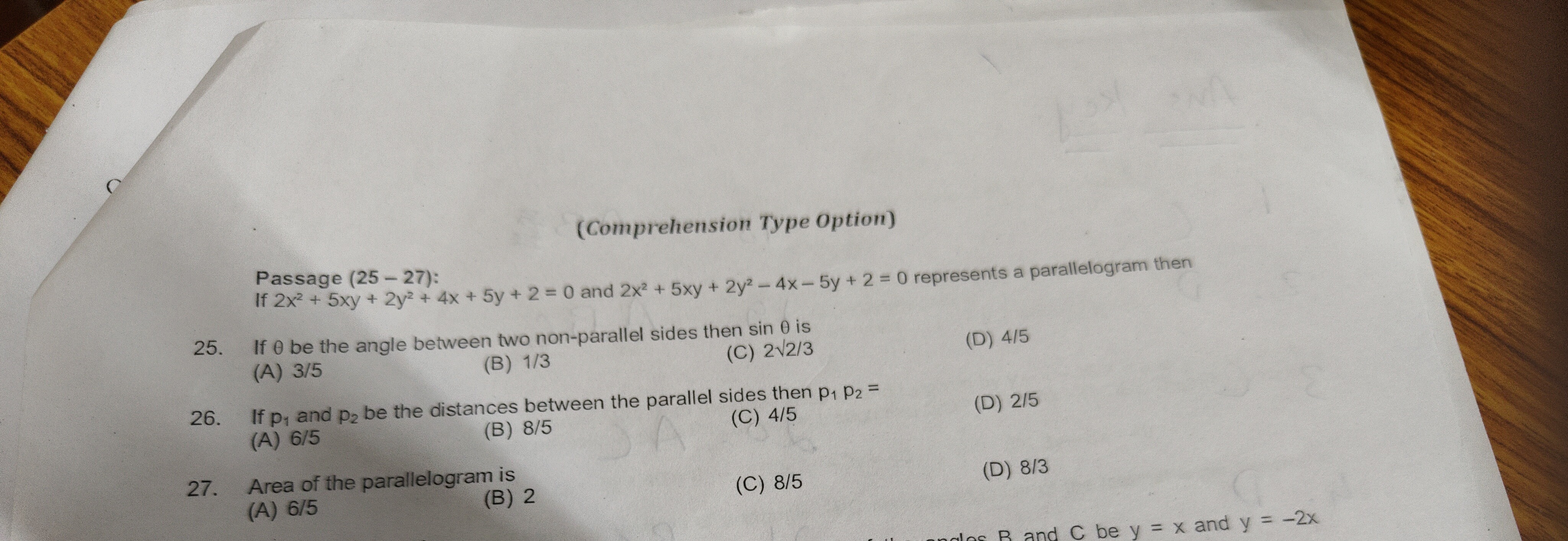Question
Question: If $\theta$ be the angle between two non-parallel sides then sin $\theta$ is...
If θ be the angle between two non-parallel sides then sin θ is

3/5
1/3
22/3
4/5
3/5
Solution
The given equations are: 2x2+5xy+2y2+4x+5y+2=0 2x2+5xy+2y2−4x−5y+2=0 Let these equations be E1=0 and E2=0. The quadratic part 2x2+5xy+2y2 can be factored as (2x+y)(x+2y). The equations can be rewritten as: E1:(2x+y)(x+2y)+(4x+5y)+2=0 E2:(2x+y)(x+2y)−(4x+5y)+2=0 Let X=2x+y and Y=x+2y. Then 4x+5y=2(2x+y)+(x+2y)=2X+Y. Substituting these into the equations: E1:XY+(2X+Y)+2=0⟹XY+2X+Y+2=0⟹X(Y+2)+(Y+2)=0⟹(X+1)(Y+2)=0. This means E1=0 represents the union of the lines X+1=0 and Y+2=0. So, 2x+y+1=0 and x+2y+2=0.
E2:XY−(2X+Y)+2=0⟹XY−2X−Y+2=0. This equation represents the other pair of parallel sides. To find the lines, we can compare it with the standard form (2x+y+c1)(x+2y+d1)=k. Expanding this, we get 2x2+5xy+2y2+(2d1+c1)x+(d1+2c1)y+c1d1−k=0. Comparing with E2=2x2+5xy+2y2−4x−5y+2=0: 2d1+c1=−4 d1+2c1=−5 c1d1−k=2 Solving the first two equations: Multiply the first by 2: 4d1+2c1=−8. Subtract the second: (4d1+2c1)−(d1+2c1)=−8−(−5)⟹3d1=−3⟹d1=−1. Substitute d1=−1 into 2d1+c1=−4⟹2(−1)+c1=−4⟹−2+c1=−4⟹c1=−2. Now, check the third equation: c1d1−k=(−2)(−1)−k=2−k=2⟹k=0. So, E2=0 represents the union of the lines 2x+y−2=0 and x+2y−1=0.
The four lines forming the parallelogram are: L1:2x+y+1=0 L2:x+2y+2=0 L3:2x+y−2=0 L4:x+2y−1=0
The pairs of parallel sides are given by (L1,L3) and (L2,L4). The angle θ between the non-parallel sides 2x+y+1=0 and x+2y+2=0. The slopes are m1=−2 and m2=−1/2. The tangent of the angle θ between two lines with slopes m1 and m2 is given by: tanθ=1+m1m2m1−m2 tanθ=1+(−2)(−1/2)−2−(−1/2)=1+1−2+1/2=2−3/2=43. If tanθ=3/4, we can form a right triangle with opposite side 3 and adjacent side 4. The hypotenuse is 32+42=9+16=25=5. Therefore, sinθ=hypotenuseopposite=53.
